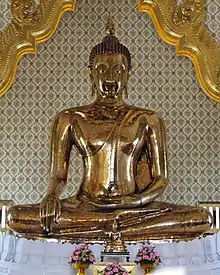Buddharupa
Buddharūpa (literally, "Form of the Awakened One") is the Sanskrit and Pali term used in Buddhism for statues or models of beings who have obtained Buddhahood, including the historical Buddha, Gautama Buddha.


| Part of a series on |
| Buddhism |
|---|
 |
|
.jpg.webp)


Commonalities
Despite cultural and regional differences in the interpretations of texts about the life of Gautama Buddha, there are some general guidelines to the attributes of a Buddharupa:
- Fingers and toes are elongated proportionately
- Long, aquiline nose
- Elongated earlobes
- Head protuberance
- Broad shoulders
The elongated earlobes are vestiges of his life as a prince, when he wore extravagant jewelry. The bump at the top of the head is the ushnisha and represents spirituality, wisdom, and awakening.[1]
Regional variations
Depictions of the Buddha vary widely across cultures.
Proportions
The image of Buddhas started to emerge from the first century CE in North India, developed in Gandhara and Mathura. The art of Gandhara was influenced by Ancient Greek art, leading to the development of Greco-Buddhist art with anatomically well-proportioned and realistic figure of the Buddha. One of the most influential Buddhist art was Gupta art and the later Amaravati style. From India the depiction of Buddha spread to the rest of Asia. The Buddharupas of India, Sri Lanka, Javanese Sailendra and Cambodian art usually depict a well-proportioned figure, but sometimes he is shown emaciated, in recollection of the Buddha's years of ascetic practices. Japanese buddharupas are often very square and stolid while Indian and Southeast Asian ones often have thinner figures.
Many people may be familiar with the "Happy" or "Laughing" Buddha, a different historical figure, who should not be confused with the images of Gautama Buddha. Budai, a Chinese Buddhist monk also known as Hotei, is depicted as fat and happy, almost always shown smiling or laughing, and is associated with Maitreya, the future Buddha.
Postures, gestures and artifacts
A statue or a painting of Buddha always illustrates a mudra or gesture. Among hundreds of mudras, the five transcendental Buddhas, also called “Dhyani Buddhas” or “Pancha Buddhas,” bear the most important mudras. These mudras are as follows.
- Dharmachakra Buddha Mudra – Vairochana:
Dharmachakra mudra has two hands held against the chest with the tips of the thumbs and forefingers of each hand united. This mudra represents a gesture of teaching.
- Bhumisparsa Buddha Mudra – Akshobhya:
This gesture, “touching the earth” (Bhumisparsa) mudra, became Buddha Akshobhya’s mudra. The Buddha called upon mother earth to bear witness to his attainment of Enlightenment. To indicate this, he touched the earth with his right hand as witness to his perfection. Thus, this mudra is formed.
- Varada Buddha Mudra – Ratna Sambhava:
In this mudra right hand lies open near his right knee. His left hand is seen holding an alms bowl. In Sanskrit, Varada means ‘granting a boon’. The gesture shows the right palm turned towards the receiver of boons, with the fingers pointed downwards.
- Dhyana Buddha Mudra – Amitabha Buddha:
This mudra has palms joined together with the right on the left, two thumb fingers touching each other. As bowl is placed in between his two palms. Here the meditating hand gesture represents a state of deep meditation and the unity of wisdom and compassion.
- Abhaya Buddha Mudra – Amoghsiddhi :
Abhaya mudra represents the hand gesture of fearlessness and protection. The gesture of fearlessness and protection, usually shown as the left hand with palm turned outward and all fingers extended upwards. The symbolic meaning of the dispelling fear pose is an interpretation of the action of preaching. It is said that one gains fearlessness by following the Bodhisattva path.
Images of Buddha sometimes show him reclining, recalling the Buddha Shakyamuni's departure into final nirvana.
Other times he is holding various symbolic objects, or making symbolic mudras (gestures).
The clothing also varies; in China and Japan, where it is considered socially improper for monks and nuns to expose the upper arm, the Buddharupa has a tunic and long sleeves, much like the traditional monks and nuns, while in India they are often topless.
See also
- Dhammacakkappavattana Sutta
- Anattalakkhaṇa Sutta
- Samaññaphala Sutta
- Mahaparinibbana Sutta
- Physical characteristics of the Buddha
- Relics associated with Buddha
- Leela Attitude
- Māravijaya Attitude
- Meditation Attitude
- Naga Prok Attitude
- Iconography of Gautama Buddha in Laos and Thailand
- Aniconism in Buddhism
- Knowing Buddha
References
- Victoria and Albert Museum. "Iconography of the Buddha". Retrieved 18 February 2014.
- Shakya, Amogh (2018-04-08). "Buddha Mudra: Meanings of Five Dhyani Buddha Mudras". Shakya Handicraft. Retrieved 2020-08-21.
Further reading
- Nirmal C. Sinha, Buddharupa observation of the evolution of the Buddha image, Bulletin of Tibetology, Vol. 1-3, pp. 18–22
External links
| Wikimedia Commons has media related to Statues of the Buddha. |
- "Thai birth day colors and Buddha image". United States Muay Thai Association Inc. 16 October 2004. Archived from the original on 2010-01-13. Retrieved 6 April 2011.
An innovation of the Ayutthaya period.
- "Borobudur Buddha head". BBC. Retrieved 2 August 2014.
A History of The World, The British Museum